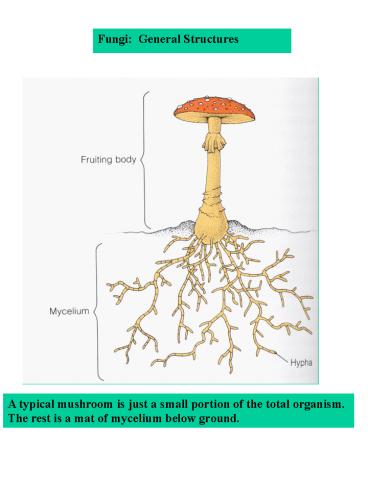Fungi: General Structures - PowerPoint PPT Presentation
1 / 18
Title:
Fungi: General Structures
Description:
Fungi: General Structures. A typical mushroom is just a small portion of the ... 3. Within the fruiting body the 2 nuclei may fuse to form a diploid zygote. ... – PowerPoint PPT presentation
Number of Views:145
Avg rating:3.0/5.0
Title: Fungi: General Structures
1
Fungi General Structures
A typical mushroom is just a small portion of the
total organism. The rest is a mat of mycelium
below ground.
2
The filamentous body of a fungus
Hyphae
Cross section to show internal organization
3
Some fungi can eject spores
4
Generalized Live Cycle of Fungi
- Spores can be or mating type. They can grow
into hyphae. - Cytoplasm of 2 cells of opposite mating types
fuse ? cell with 2 nuclei. - This cell can give rise to more hyphae,
which may form a fruiting body. - 3. Within the fruiting body the 2 nuclei may
fuse to form a diploid zygote. - The zygote undergoes meiosis to produce
haploid spores.
5
(No Transcript)
6
Chytrid filaments
Chytrids live in water, have flagellated
spores, and probably gave rise to the other
groups.
7
Life cycle of a zygomycete, Rhizopus, the black
bread mold.
Spores (haploid)
Hyphae of opposite mating types meet and fuse
Zygospore germinates
Sporangia
Nuclei in common cell fuse
Meiosis occurs as zygospore germinates
zygospore
named for
8
Ascomycetes (sac fungi)
Sac fungi form spores in a saclike case called an
ascus.
This group includes morels, yeasts, the
species that produces penicillin, and molds that
destroy fruits and grain crops.
9
The basidiomycetes (club fungi) include
mushrooms, puffballs, shelf fungi and stinkhorns.
10
The life cycle of a typical basidiomycete.
Haploid nuclei fuse to form zygote
Mushroom gills bear reproductive basidia
Named for
Mushroom develops from aggregated hyphae
Basidiospores germinate, forming hyphae (1 n)
Compatible hyphae fuse and grow into mycelium,
but 1 n nuclei in mycelium remain separate
11
Mushrooms emerge in a fairy ring from an
underground fungal mycelium, growing outward from
a central point where a single spore germinated,
perhaps centuries ago.
12
The lichen a symbiotic partnership
13
Mycorrhizae Fungus-Plant Associations
No mycorrhizae With mycorrhizae
Some species of myccorrhizae can grow inside
plant root cells
14
Plants grow better in this symbiotic relationship
15
Corn smut
This basidiomycete pathogen destroys millions of
dollars worth of corn each year.
16
A helpful fungal parasite
This fungus kills grasshoppers, and is used by
farmers to control the grasshopper pests.
17
The unusual yeast
This yeast is Candida, a common cause of vaginal
infections.
18
Penicillium
The antibiotic penicillin was first isolated from
this fungus.































